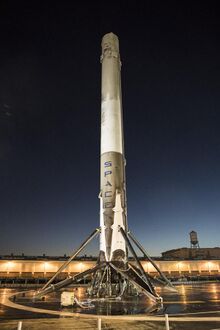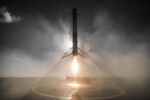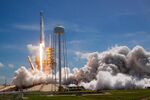Engineering:Falcon 9 booster B1029
| Falcon 9 booster B1029 | |
|---|---|

| |
| B1029 landed on a drone ship in the Pacific Ocean after helping lift ten Iridium NEXT communication satellites to orbit on 14 January 2017 | |
| Role | First stage of orbital rocket |
| National origin | United States |
| Type | Falcon 9 first-stage booster |
| Manufacturer | SpaceX |
| Construction number | B1029 |
| First flight | 14 January 2017 (Iridium NEXT 1–10) |
| Last flight | 23 June 2017 (BulgariaSat-1) |
| Flights | 2 |
Falcon 9 booster B1029 is a first-stage reusable rocket booster for the Falcon 9 orbital launch vehicle manufactured by SpaceX. B1029 was the second orbital-class booster in the history of rocketry to be flown again after a vertical landing. It was also the first to land without damage on an autonomous spaceport drone ship in the Pacific Ocean[1] and to be launched from both coasts of the United States.[2]
Manufacturing
Falcon 9 booster B1029 was designed and produced primarily at the SpaceX Hawthorne production facility[3] before undergoing testing at the company's rocket development and test facility in McGregor, Texas.[4] It was then transported to Vandenberg Air Force Base in California to prepare for its first mission.
First launch
B1029 was first launched on 14 January 2017 from Vandenberg pad SLC-4E for the 29th Falcon 9 mission carrying ten Iridium NEXT communication satellites to a 780-kilometre (480 mi) altitude low Earth orbit.[5] It was designated B1029.1 for the first launch. After separating from the second stage, it performed a boost-back burn of three engines to reduce its horizontal velocity and re-entered the atmosphere guided by its software and grid fins.[6] Nine minutes into the flight, it performed a final engine burn to land smoothly on SpaceX's drone ship Just Read the Instructions stationed in the Pacific Ocean a few hundred miles off the Baja California coast.[7] A continuous video stream shows the deployment of grid fins in space, the protective engine burn for atmospheric entry, controlled gliding during ballistic flight and final maneuvers to land on the drone ship.[6]
Second launch
After recovery, inspections and refurbishing, this first stage was delivered to Kennedy Space Center in Florida on 3 June 2017, and subjected to a mock countdown and static test fire on 15 June on historic launch pad LC-39A.[8] It was launched for the second time as B1029.2 on 23 June 2017, on the 36th Falcon 9 mission, helping lift the BulgariaSat-1 communications satellite into geostationary transfer orbit (GTO). The stage performed the same boost-back and re-entry maneuvers, and was safely recovered on the Of Course I Still Love You drone ship positioned in the Atlantic Ocean. During the recovery sequence, the stage reached a maximum velocity of Mach 7.9, the highest for a successfully recovered booster thus far.[9] This event further reinforced the viability of the SpaceX reusable launch system development program to accelerate launch cadence and reduce costs of access to space.[2]
Fate
(As of June 2017), the fate of the B1029 booster had not yet been announced. Due to the stress of atmospheric re-entry from a GTO mission, it is unlikely to be flown again. SpaceX founder Elon Musk described the state of the rocket as "extra toasty" upon landing.[10] The previous first stage re-flown in similar conditions, B1021, was retired from service and will be donated to the Cape Canaveral Air Force Station for public display.[11]
List of missions
| Flight № | Launch date, time (UTC) |
Mission №, payload, mass, orbit |
Liftoff | Landing | Spaceport, launch pad |
Landing location |
|---|---|---|---|---|---|---|
| 1 | 14 January 2017 17:54 UTC |
Falcon 9 flight 29 Iridium NEXT 1–10 9,600 kg (21,200 lb) to LEO altitude 780 km (480 mi) |
Vandenberg SLC-4E |
Drone ship Just Read the Instructions, Pacific Ocean | ||
| 2 | 23 June 2017 19:10 UTC |
Falcon 9 flight 36 BulgariaSat-1 3,669 kg (8,089 lb) to GTO altitude 35,786 km (22,236 mi) |
Kennedy LC-39A |
Drone ship Of Course I Still Love You, Atlantic Ocean |
See also
- List of Falcon 9 first-stage boosters
- SpaceX reusable launch system development program
- Falcon 9 first-stage landing tests
- McDonnell Douglas DC-X
- Blue Origin New Shepard
- Scaled Composites SpaceShipOne
References
- ↑ Clark, Stephen (17 January 2017). "Falcon 9 booster, first recovered off West Coast, back in port". Spaceflight Now. https://spaceflightnow.com/2017/01/17/falcon-9-booster-first-recovered-off-west-coast-back-in-port/.
- ↑ 2.0 2.1 Cite error: Invalid
<ref>tag; no text was provided for refs namednsf-20170623 - ↑ "Production at SpaceX". SpaceX. 24 September 2013. http://www.spacex.com/news/2013/09/24/production-spacex.
- ↑ "Inside SpaceX’s Texas Rocket-Testing Facility". Wired. 10 October 2012. https://www.wired.com/2012/10/spacex-texas-rocket-test/.
- ↑ "Iridium NEXT". eoPortal Directory. European Space Agency. https://directory.eoportal.org/web/eoportal/satellite-missions/i/iridium-next.
- ↑ 6.0 6.1 SpaceX (14 January 2017). Iridium-1 Hosted Webcast. Retrieved 25 June 2017.
- ↑ Clark, Stephen (14 January 2017). "SpaceX resumes flights with on-target launch for Iridium". Spaceflight Now. https://spaceflightnow.com/2017/01/14/spacex-resumes-flights-with-on-target-launch-for-iridium/.
- ↑ Clark, Stephen (15 June 2017). "Falcon 9 launch scheduled for Monday after hold-down engine firing". Spaceflight Now. https://spaceflightnow.com/2017/06/15/falcon-9-launch-scheduled-for-monday-after-hold-down-engine-firing/.
- ↑ @elonmusk (25 Aug 2017). "Max recovered booster velocity was Mach 7.9 (BulgarianSat [sic). Energy is velocity squared, so this is a bigger difference than it appears"]. https://twitter.com/elonmusk/status/900994666660626432.
- ↑ Cite error: Invalid
<ref>tag; no text was provided for refs namedMusk-toasty - ↑ Dunn, Marcia (5 April 2017). "Reused rocket back in port after satellite launch by SpaceX". Associated Press. https://apnews.com/d49c80f42e474969b2298fa8a21b42d5/reused-rocket-back-port-after-satellite-launch-spacex.
External links
- Iridium-1 Hosted Webcast on YouTube, containing notably a continuous stream of B1029 performing its atmospheric re-entry, controlled descent and landing maneuvers, from 24:45 to 28:00 into the webcast





